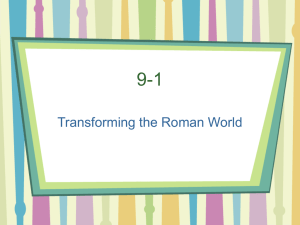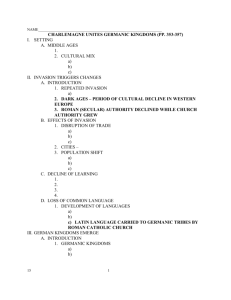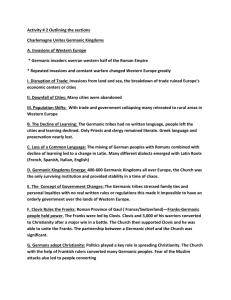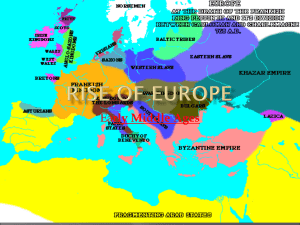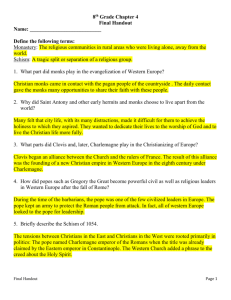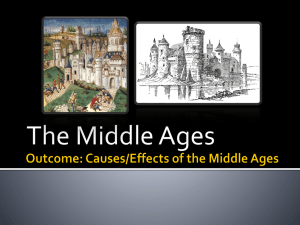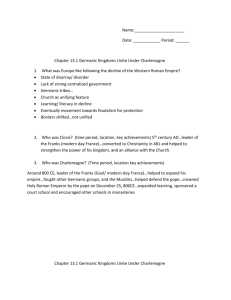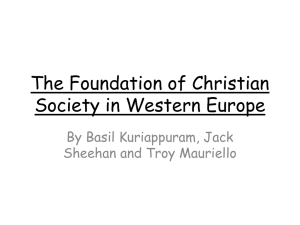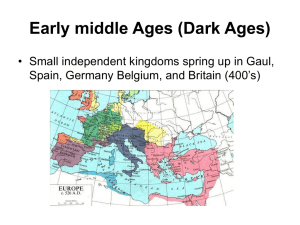Transforming the Roman World - Mounds View School Websites
advertisement
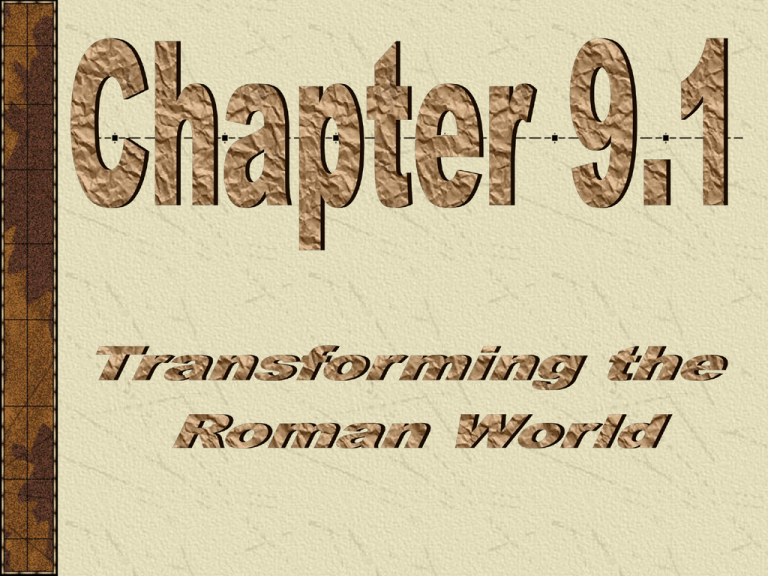
The Romans had controlled most of Europe (all of Western Europe) from about 117 AD to 476 AD By 476 AD, Rome was not able to keep control over its empire -began to lose control on the frontier regions A new European civilization is created based on: 1. Influence of Germanic tribes 2. Legacy of the Romans 3. Influence of the church Germanic peoples began moving into Roman territories as early as 3rd century Visigoths in Spain Ostrogoths in Italy (5th century) Basques in northern Iberia (still looking for a homeland) After Rome was sacked in 476, many original documents moved to Constantinople Visigoths and Ostrogoths maintained Roman style government, but excluded Romans from holding power In Britain, Romans abandoned their forts Angles and Saxons settled and created an AngloSaxon culture Clovis I: Frankish ruler from 481 to 511 Became first Germanic ruler to convert to Christianity (this occurred during a battle with the Alamanni, Clovis army near destruction, he called on the Christian god to help him in battle, and his army was victorious) Baptism of Clovis I, from Encarta Online His wife was Christian, but she was not able to convince him to convert until this event This conversion gave Clovis and the Franks support from the Catholic church Clovis and the Franks were also obliged to protect the church in Rome By 510, Clovis had united all of the Franks into one kingdom Upon his death, his kingdom was divided equally among his sons—following traditional Frankish custom Throughout Europe, Germans and Romans began to intermarry which created a new society Many of the new governments adopted aspects of the Romans But Germanic social customs began to play a more important role In Germanic society, family was the crucial social bond Focused especially on the extended family These groups worked their land together These groups also protected each other In Roman law, serious crimes were considered crimes against the state In Germanic society, crimes were considered personal and often led to blood feuds or other savage acts of revenge Wergild: new system developed to avoid violence Word means: “money for a man” This was the amount of money paid by a wrongdoer to the family of the person injured or killed Varied by crime, but also varied by social status Ordeals: were used to help determine guilt -based on the idea of divine intervention What was the significance of Clovis’s conversion to Christianity? This conversion gained him the support of the Roman Catholic Church Organization of the Church Pope Diocese: led by archbishop Bishopric: led by bishops Parish: led by priests Pope: was bishop of Rome Became recognized by Western Christians as leader of church government church Pope Gregory I (Gregory the Great) Was pope from 590 to 604 Took spiritual and political control of Rome and its territory (Papal States) Was responsible for the conversion of many Germanic peoples to Christianity through the monastic movement Monk: A man who separates himself from human society in order to totally dedicate his life to God Monasticism: The practice of living the life of a monk Abbot Paul Delatte from http://homepage.mac.com/fahrenheit451/quarr/sole Saint Benedict: Founded a community of monks in 6th century Wrote rules he thought monks should live by (Benedictine Rule) Important aspects of Benedictine Rule: “The Proper Work of God” (prayer) -monks prayed together as a community seven times each day -other times of day required individual meditation and prayer to God Idleness is the “Enemy of the Soul” -physical work required of all monks several hours each day Benedict believed monastic life should be communal -monks ate, worked, slept, and worshipped together -no private property Abbot: Ruled each monastery Had complete control Monasteries owned their own land -were self-sufficient and isolated Monasteries came to be seen as the ideal Christian society -provided a moral example to the surrounding society Monasteries provided social services to local communities: -schools for youth -hospitality for travelers -hospitals for sick -improved agriculture techniques and production -were excellent craftsmen Missionaries: people sent out to carry a religious message Christian missionaries spread and converted many Germanic people By 1050, most western Europeans were Catholic Nuns: women who withdrew from the world -lived in convents -abbess: led each convent -also contributed to the spread of Christianity What was the role of the Catholic Church in the growth of the new European civilization? Through its monasteries, it converted the pagans, spread learning, and provided social services Monks became the new heroes of Christian civilization Mayors of the palace: Chief officers of the Frankish kings households -began to gain power over the Frankish kings Pepin the Short: mayor who assumed kingship of the Franks -Pepin was the son of Charles Martel -died in 768 -his son Charles became king Charles Martel’s army defeated an Islamic army at the Battle of Tours in 732 -stopped the spread of Islam further into western Europe Charlemagne (Charles the Great): -Pepin the Short’s son -ruled from 768 to 814 -determined, decisive, highly intelligent, curious -fierce warrior, strong statesman, devout Christian -couldn’t read or write, but supported education Charlemagne expanded Frankish rule, created the Carolingian Kingdom (in green above) Counts: German nobles who acted as Charlemagne’s representatives in local areas Missi dominici: “messengers of the lord king” -men from Charlemagne’s staff who traveled to local districts to check on the counts -this event demonstrated strength in the idea of an enduring Roman Empire Charlemagne crowned as first Holy Roman Emperor This coronation marked the ‘coming together’ of Roman, Christian, and Germanic elements -it marks the beginning of a new civilization in Europe 4 minutes Carolingian Renaissance: Charlemagne’s desire to promote learning led to a revival of learning and culture -a renewed interest in Latin culture and classical (Greek and Roman) works Scriptoria: Monastic writing rooms -became crucial in the preservation of ancient manuscripts (Bible, Latin scholars, Greek and Roman works…) -most of these ancient works that survive today were preserved by monks What was the importance of missi dominici? They were the messengers of the king (or lord) who ensured that the counts were carrying out the king’s orders They were a way to centralize administration and keep the counts under the power of the king Wergild: “money for a man” The value of a person in money, depending upon social status, in Germanic society A fine paid by a wrongdoer to the family of the person he or she had injured or killed Ordeal: A means of determining guilt in Germanic law Based on the idea of divine intervention: if the accused person was unharmed after a physical trial, he or she was presumed innocent Bishopric: A group of Christian communities, or parishes, under the authority of a bishop Pope: The bishop of Rome and head of the Roman Catholic Church Monk: A man who separates himself from ordinary human society in order to dedicate himself to God Monks live in monasteries headed by abbots Monasticism: Practice of living the life of a monk Missionary: A person sent out to carry a religious message Nun: A woman who separates herself from ordinary human society in order to dedicate herself to God Nuns live in convents Abbess: The head of a convent Summarize the crucial bond among the Germanic peoples and one area of its application. The crucial bond was family It affected the concept of crime and punishment List the daily activities of Benedictine monks. Prayer and manual labor What significance did Charlemagne’s coronation as Roman emperor have to the development of European civilization? It symbolized union of Roman, Christian, and Germanic elements Fill in the chart with significant events in the religious and political realms for each listed leader. Ruler Religious Realm Political Realm Clovis Conversion Frankish kingdom Gregory I Extended papal authority Controlled Rome Charlemagne Crowned by Pope Carolingian Empire

